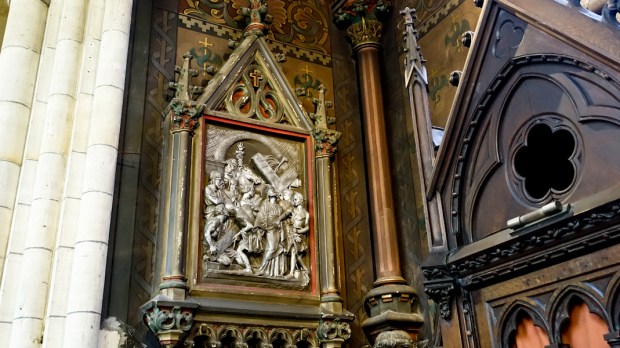When you walk into any Catholic church in the United States there is one architectural feature that is present almost everywhere you go: the Stations of the Cross. The stations might be featured in stained glass windows or in beautiful paintings, or depicted in statues or wall reliefs that line the sides of the church.
Why is that? And where did the Stations of the Cross come from anyway?
To answer that question we have to go all the way back to 33 AD.
The original Via Dolorosa
An ancient tradition has it that the Blessed Virgin Mary visited the sites of Jesus’ suffering, death and resurrection on a daily basis after his ascension into Heaven. Additionally, there are other traditions that claim Mary followed Jesus as he took his cross to Calvary. She was the first to accompany Jesus along his via dolorosa (sorrowful way)and it did not take long for pilgrims to imitate her example and walk that lonesome road of Christ’s suffering and death.
By the reign of Emperor Constantine various churches and markers were set up at specific points on Jesus’ path to Calvary. Pilgrims traveled to the Holy Land for many centuries to visit these sacred sites, often taking something back with them to remember their journey.
Travel to the Holy Land, however, was not always easy or even permitted. It remained a hotspot of religious tension and many wars prevented Christians from making the journey. In lieu of traveling to theses holy sites, the Franciscans and others throughout Europe decided to create shrines and replicas in local towns. The goal was to help the faithful enter into Jesus’ Passion without having to make a life-threatening trip. There were even attempts to reproduce the exact paces between the original sacred spots so that the replicas were as true to Jerusalem as could be.
In 1342 the Franciscans were appointed special guardians of the sacred sites in the Holy Land, and soon after we see the first mention of the word “stations” to denote the various stops along the way of Jesus’ passion. Franciscans continued to replicate these holy places throughout Europe in outdoor shrines that became very popular.
Modern-day Stations of the Cross
By the 17th century the Franciscans wanted to begin erecting these “stations” within the church walls and asked Rome for permission. Additionally, they wanted the faithful to be granted the same indulgences that would have been given to those who traveled to Jerusalem. According to the Catholic Encyclopedia, Pope Innocent XI recognized the need and granted their request.
“Realizing that few persons…were able to gain [indulgences] by means of a personal pilgrimage to the Holy Land, Innocent XI, in 1686, granted to the Franciscans…the right to erect the Stations in all their churches, and declared that all the indulgences that had ever been given for devoutly visiting the actual scenes of Christ’s Passion, could thenceforth be gained by Franciscans and all others affiliated to their order if they made the Way of the Cross in their own churches in the accustomed manner. Innocent XII confirmed the privilege in 1694 and Benedict XIII in 1726 extended it to all the faithful. In 1731 Clement XII still further extended it by permitting the indulgenced Stations to all churches, provided that they were erected by a Franciscan father with the sanction of the ordinary. At the same time he definitely fixed the number of Stations at fourteen.”
Read more: What are indulgences?
In the United States Franciscans helped found many parishes throughout the country and were instrumental in the early formation of the Catholic Church in the New World. It is likely that their influence helped make the Stations of the Cross a vital part of American spirituality.
So the next time you see a Franciscan, thank them for bringing the Stations of the Cross to the United States!
Read more: How to pray the Stations of the Cross as if you were there

